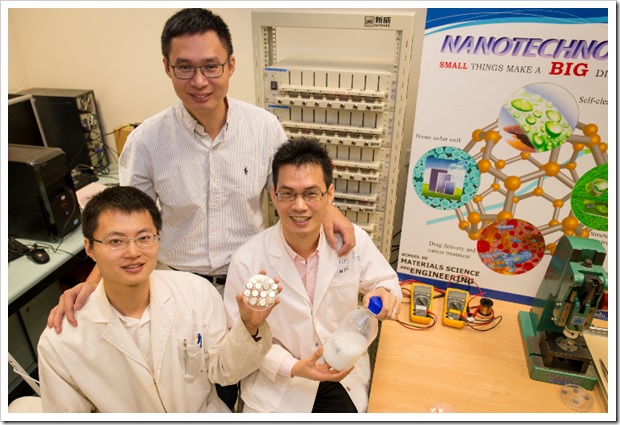Scientists Invent Battery That Can Be Fully Charged Under 3 Mins & Lasts 20 Years
The worst nightmare for a typical user of smartphone or tablet is only one scenario: Battery drained. So often it happens that you are about to leave your home, and suddenly you notice that battery is empty. Or, you have an important meeting to attend, and there is no time left to charge your gadget.
We have always said that biggest bottleneck the Smartphone Industry is facing today is the Battery limitations.
A typical smartphone battery needs at least 2 hours to fully charge, despite advances in technology and cheap hardware.
A new type of lithium ion battery has been recently invented by scientists from Nanyang Technological University in Singapore, which can be fully charged in 2.8 minutes; and can last 20 years.
Hence, this battery can be charged by the time you search for your car keys inside the home, or less than the time which is required to fill up petrol in your car (counting the waiting and billing time).
This new lithium ion battery has been invented by Associate Professor Chen Xiaodong from NTU’s School of Materials Science and Engineering.

How Does It Work?
The existing lithium ion batteries which are used in almost all smartphones, tablets and laptops have a shelf life of 500 recharge cycles, after which they are not usable anymore. And 500 recharge cycles ends in approximately 2 years.
This new battery has actually replaced the negative pole of the lithium ion battery, also called Anode, with a brand new gel material made from titanium dioxide nanotubes; which Chen Xiaodong and his team has developed themselves.
These nanotubes are thousand times thinner than a normal human hair, and due to their tiny structures, ions and electrons can transfer from positive to negative poles in a faster way, thereby making the process of charging blazing fast.
This also means that the energy which can be packed in that little space is 20 times more than a normal lithium ion battery can accommodate, thereby directly increasing the recharge cycles to 10,000, instead of 500 which is supported currently. 10,000 recharge cycles means that this battery can last minimum 18-20 years.
Advanced Materials, which is a well-known publication in the field of cutting edge scientific research has published a paper which demonstrates the working of these nanotubes. The research paper titles: “Mechanical Force-Driven Growth of Elongated Bending TiO2-based Nanotubular Materials for Ultrafast Rechargeable Lithium Ion Batteries” can be read here.
6 Major Advantages Which Are Speculated
– Smartphones and tablets, laptops and other electronic gadgets will receive a energy boost, thereby making the products more useful and practical.
– Less energy would be consumed while charging batteries
– Electric cars will get a major boost: both from usability side and marketing side. The biggest obstacle while selling an electric car is the time taken for charging. Using these new lithium ion battery with nanotubes will complete the process of charging huge electric car batteries within minutes. The time taken for a petrol/diesel car to be filled will be the same for charging an electric car.
– By increasing the recharge cycle of batteries, and making them last 20 years, they are high on environment friendliness. Lesser batteries would be decomposed or destroyed, thereby giving us an ecological boost as less toxic waste would be generated.
– Manufacturing is easy: Titanium dioxide and sodium hydroxide are mixed and stirred under a controlled environment, which becomes a gel like material. Existing battery manufacturers will find it super easy to integrate this new material with their existing production of lithium ion batteries.
– The best part: It will be cheap. As titanium dioxide is easily found in the soil, these batteries are expected to be mass produced using less resources.
As per the blog post published by NTU, this new battery technology has been licensed to a company which will mass-manufacture the product in two years.
As per estimates by Frost & Sullivan, the market for rechargeable lithium ion batteries will swell to $23.4 billion by 2016. Gauging by the incredible sales of gadgets and wearable devices, not to mention the booming electric car market, batteries are the most important entity for the technological world.
And this new battery powered by nanotube gel can make a major dent in the overall market.

[…] Invent Battery That Can Be Fully Charged Under 3 Mins & Lasts 20 Years. Luckily Scientists from NTU in Singapore have developed a battery, which can be fully charged in […]
Hope Tim Cook read this!!
Apple devices need this battery more than anyone else. :P
So often we read such news about long lasting battery for smartphone, cars etc.. But in reality no product is being commercialized or mass manufactured. Hope this time this would change.
Now when can I run my car with this battery?
Yes, it can replace any traditional battery. You may not know, but one of the biggest issue such inventions do not see commerical production is because Battery companies stand to lose billions of dollars and they have a strong lobby, which makes it difficult for such inventions to be commercially available.!